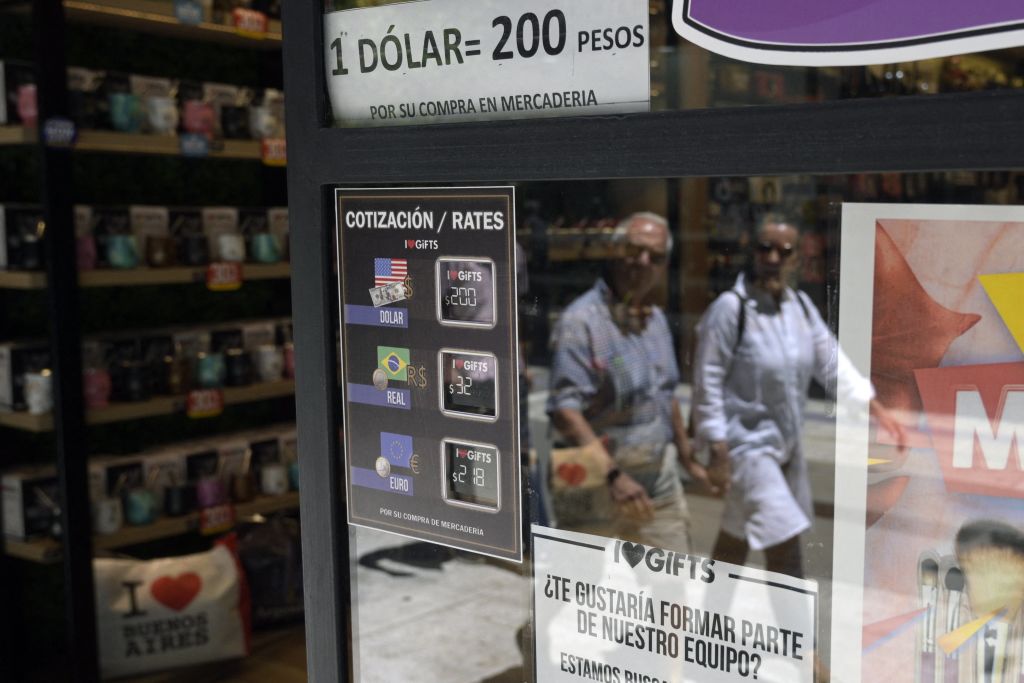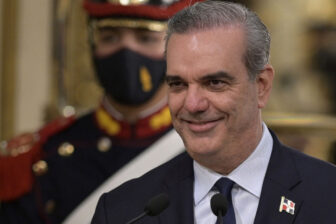BUENOS AIRES – In April 2002, four months after the collapse of the currency’s peg to the dollar, Argentina’s inflation reached 10% per month. The economic debate saw a range of proposals—from turning the domestic banking system into an offshore money market (virtually eliminating domestic credit) to giving up Argentine financial and economic sovereignty for a few years. But none was more popular than official dollarization.
By the end of the year, thanks in part to a mix of monetary and fiscal policy (as well as an external debt restructuring and a local debt currency conversion), inflation was down to 3% annually and the dollarization debate was dead in the water. So much so that presidential frontrunner and dollarization champion Carlos Menem had to make an ultimately unsuccessful 180-degree turn to adapt to the new zeitgeist.
In policymaking, extreme situations don’t always call for extreme measures, even though public opinion often does. With price increases in Argentina currently running at a monthly rate of 6.7%, signaling a floor of 60% for the year, dollarization proposals are flourishing once more as a “disruptive” shortcut to put an end to inflation. And since the government seems to lack a realistic plan, conviction or political capital to stabilize the economy, the debate is unlikely to go away—at least not before the October 2023 election.
Argentina is not alone in exploring a stronger role for the U.S. dollar. Dollarized Ecuador seems so far immune from inflation, while after seven years of hyperinflation, a dollarization debate is gaining momentum in Venezuela. But as is typical in political debates, advocates often leave out critical technical aspects, highlighting the pros and downplaying the cons. Let’s look at some examples to try to fill in those gaps.
What do we talk about when we talk about dollarization?
Official dollarization proposals come broadly in two versions: hard dollarization (adopting the U.S. dollar as the sole legal tender, like in Ecuador or El Salvador), and soft dollarization (the dollar as an alternative to the local currency like in Peru and Uruguay or, more recently, Venezuela).
Because hard dollarization entails replacing the monetary base with the available dollars, the conversion rate would depend on the stock of net reserves and can be exceedingly high. In Argentina, for example, dividing the monetary base (3.7 trillion pesos) by the stock of net reserves ($6.1 billion after the IMF program disbursement) would yield an initial exchange rate of at least 600 pesos per dollar, many times above both the official and the parallel markets.
In fact, the initial parity could be considerably higher if we take into account that the central bank should keep an important liquidity buffer to prevent runs on a dollarized banking system, as is the case in other dollarized economies. For this reason, many dollarization advocates imagine launching it after a hyperinflation and a sharp devaluation dilute the dollar value of the stock of pesos, as in Argentina prior to its currency board (a variety of soft dollarization) in 1991, or in Ecuador’s own pre-dollarization debacle in 1999. Paradoxically, then, this plan to lower inflation needs hyperinflation as a precondition.
The Venezuelan dollarization dilemma
Venezuela provides a peculiar example of a soft—albeit de facto—dollarization introduced after an unusually protracted hyperinflation. Together with a draconian fiscal adjustment, the use of foreign currency has been tolerated and even promoted by the government since late 2019 to combat the inevitable flight from the bolivar and its impact on real activity. Recently, the authorities seem to be backsliding on the idea—or profiting from it—as indicated by a new 3% tax on dollar transactions to boost fiscal revenue. Prices are in dollars and payments in bolivars are converted at the parallel exchange rate, while local banknotes are held mainly as spare change in the absence of lower denomination dollar bills and coins. While the government continues to collect the inflationary tax to finance its fiscal deficit, the monetary base accounts for less than 0.5% of GDP and could be readily dollarized with a fraction of the central bank’s reserves—if the country could bypass economic sanctions and make them liquid.
The relevant question for Venezuela is not an eventual de-dollarization—this would demand an improbable nominal stabilization as a necessary condition—but rather the very viability of the national currency and the convenience of a hard dollarization that completes the ongoing process. To answer this, it helps to note that Venezuela is both an oil exporting country (with volatile terms of trade shocks that would recommend a managed floating exchange rate) and, due to its massive diaspora, a remittance country receiving a stable dollar inflow (which, as in El Salvador, makes official dollarization less disruptive). While the mix of falling oil exports and growing remittances seems to favor official dollarization, the country can hardly grow without regaining its oil-producing potential. Official dollarization, far from eliminating this external constraint, would freeze the situation at the current low level of income. Thus, official dollarization could be seen as a litmus test of political expectations in Venezuela, one that would signal that no political change or true economic rebound is in the cards.
Promises, promises
Hard dollarization has other hidden surprises. For example, in Argentina it would require the forced conversion (and consequent dilution) of peso-denominated securities at an artificially high exchange rate. Even in financially dollarized economies with most savings held abroad, as in Argentina, peso deposits and assets still carry—due to the tight exchange rate controls—a non-negligible share of the working capital of small and medium-sized businesses and the savings of middle and low-income households. These would lose most of their value with the regime change.
Moreover, classic dollarization, unlike its “lite” version, is virtually irreversible. To forcefully convert contracts to a weakening currency is arduous and questionable, but still feasible; to do that to currency in circulation (which is what reversing dollarization is all about) is virtually impossible. The two countries that officially dollarized in the late 1990s, the heyday of superfixed exchange rate regimes—El Salvador (in normal times) and Ecuador (in the midst of a currency collapse)—have since learned that, even if they do their homework, they are exposed to external shocks (oil prices; Chinese competition; global financial cycles; pandemics and wars) without the capacity to use the exchange rate as a buffer. As one of us documented in a recent piece, both countries have prudently explored ways out, but have ultimately resigned themselves to the fact that dollarization is a one-way road. The problem with burning our ships is that, if we miscalculate, we may need to swim back.
Regarding the advantages, on paper official dollarization offers pretty much the same payoffs as Argentina’s currency board did in the early 1990s: a sudden brake on inflationary inertia by giving up on monetary policy, cutting the monetary financing of the deficit and forcing fiscal discipline as a result.
But history casts serious doubts on those aspirations. Argentina’s currency board was a hit during its first five years because the government restructured peso liabilities, the Brady Plan pushed forward the debt service and lightened the fiscal deficit, the country implemented a fiscal adjustment coupled with productivity-enhancing reforms, and the dollar weakened globally. It lost its groove in its second five years when the government traded fiscal discipline for external debt right before the global rebound of the dollar triggered a thread of emerging market currency crisis that put the nail in the coffin of the Argentine miracle.
A telling corollary to the crisis was the decision by the Argentine treasury, cut off from the market and without a central bank to finance the deficit, to print fiat money in 2001 under another name (the so-called LECOP)—demonstrating, once again, that discipline is seldom decreed by law.
Soft dollarization
In the soft variant of dollarization, the dollar would compete with the peso as legal tender. Salaries, prices of goods and services and taxes could be denominated and settled in the foreign currency. Thus, in addition to the dollarization of savings, the soft version adopts the dollar as a means of payment and unit of account, in what is usually referred to as real dollarization.
While real dollarization may reduce transaction costs and shield against dilution risks, it is still not free from the possibility of forced conversion, which may limit its upside in terms of the repatriation of savings offshore and the deepening of domestic markets beyond the typical short-term investors.
On the downside, a widespread use of the dollar as a means of payment would destabilize the demand for pesos and complicate monetary policy. In this light, inflation and devaluation would become self-fulfilling prophecies: Devaluation expectations trigger a substitution of dollars for pesos, which in turn depresses the demand for pesos, fueling inflation and devaluation (and validating expectations). Interestingly, this same feedback logic may also apply to soft dollarization itself, if peso bondholders anticipate that a regime change would require the restructuring of peso debt and run for the exit.
To mitigate this problem, advocates propose the dollarization of bank deposits and loans, but this introduces a second risk: financial fragility. Again, the currency board debacle illustrates the point. A dollar deposit run, fueled by the fear that a devaluation would make dollar loans to peso earners uncollectible, led to a compulsory conversion to pesos to avoid a generalized bankruptcy of the system—validating the fears. Indeed, it was this lesson, embedded in the restriction to banking dollarization imposed in 2002, that allowed Argentina to go through two episodes of financial stress (in 2012 and in 2019) without a banking crisis. Paradoxically, then, a soft dollarization plan to stabilize the economy would need to reintroduce financial fragility as a precondition—although, come to think of it, it makes sense, since the currency board was itself an example of soft dollarization.
Without a full-blown crisis, dollarization is certainly not a desirable starting point to stabilize the economy, nor is it a necessary condition for a return to growth. There are few substitutes for the politically costly fiscal consolidation, monetary discipline, and relative price adjustments that are at the basis of any realistic stabilization program.
—
Levy Yeyati is dean of the School of Government at Torcuato di Tella University in Buenos Aires and a nonresident senior fellow at the global economy and development program at Brookings.
Dal Poggetto is executive director of Eco Go Consultants and author of Tiempo Perdido (2021).








